How to Quickly Test Your Business Idea: The Case of Farel

In this post, I’d like to share how I tested the idea of Farel, validated market demand, and share what we’ve achieved over the past year. By sharing practical insights, I hope my experience can be useful for other B2B startups currently at the idea stage.
Farel started with a simple hypothesis: airlines need simple and easy-to-use software for their operations. In April 2020, I finally decided to study this direction in further detail. For over a year, the idea drilled my mind incessantly. You know that feeling when an idea comes up and you cannot sleep or think of anything else? I’ve built three businesses from the ground up before, and they all started the same way. It was a strong, positive signal for me, but still not enough to become completely obsessed with starting a new business.
First and foremost, I wanted to figure out whether my hypothesis was just mere delusion. What if airlines were comfortable with their current software? What is industry inertia simply made them afraid to change?
I thought to myself, “Okay, I can devote some time to validate this idea.” My current business, at that time, was also involved in the traveltech space. We were a large online travel agency in the CIS and engaged directly with the software used by the airlines.
So what was the initial problem? There are only a few players on the airline software spaсe, like Amadeus and Sabre, which essentially control the entire market. The problem is that their software was created a long time ago and has since devolved into becoming archaic. Yes, the companies are developing new features, but they are based on an old core that has not been changed for decades. The state of affairs can be compared to that of the automotive industry. Although combustion engines dominate the market today and manufacturers are still investing in improvements, it is clear that this is an outdated technology, and the future lies with electric drive systems.
What are the other inefficiencies? For example, these solutions have a command-line interface.
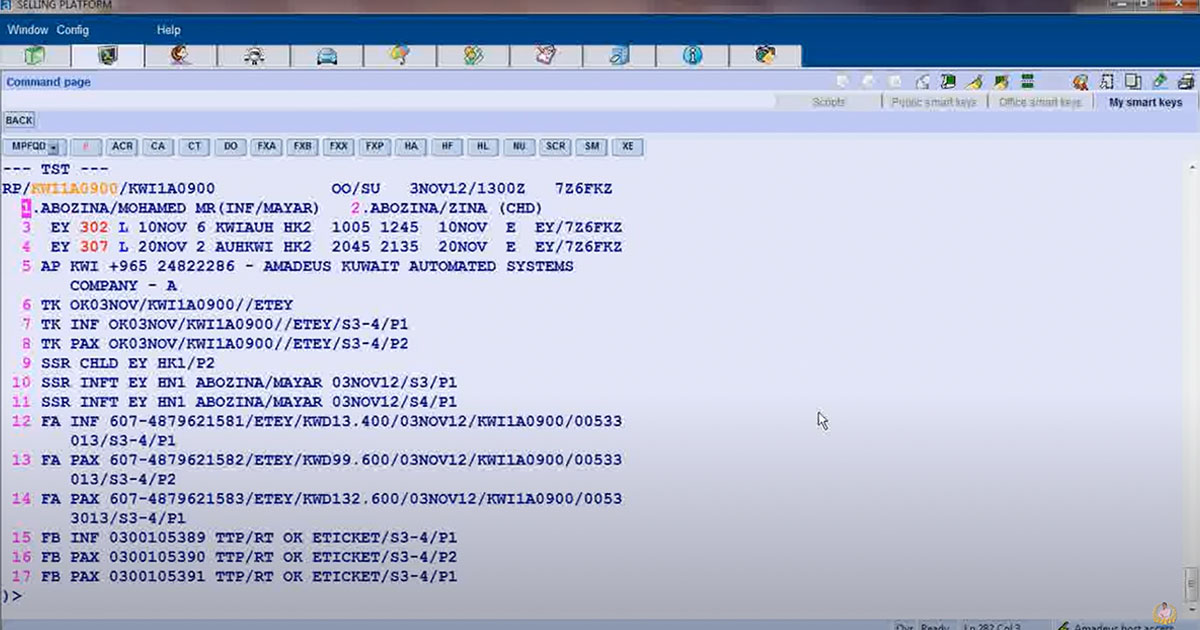 Command-line interface
Command-line interfaceTo perform even the simplest actions, users must know a special syntax and enter hundreds of commands to get results. And this is happening in the age of intuitive web interfaces! For comparison’s sake, let us look at the past, when to create even a simple website, one needed to know HTML. Now, you can create a website using a constructor by rearranging blocks and designs exactly as you want. In addition, current software is not cloud-based, meaning that a separate configuration is made for each customer and is then supported individually. Back in the day, if a business needed computing resources, they had to buy servers and build an infrastructure for their operations – an extremely costly and time-consuming task. Today, AWS has essentially made this function obsolete.
Further it’s extremely difficult for airlines, especially smaller ones, to have any kind of specialized solutions developed by software manufacturers. For example, why is getting a ticket refund not as simple as buying one? What is the problem of having it done in a few clicks? Today, ticket refunds or exchanges are a manual process for most carriers and there is almost no alternative to the current software. In fact, the market is oligopolized, and airlines have almost no say in it. They also need to maintain good relations with suppliers, otherwise they run the risk of unfavorable commercial terms in the next contract. A vicious cycle.
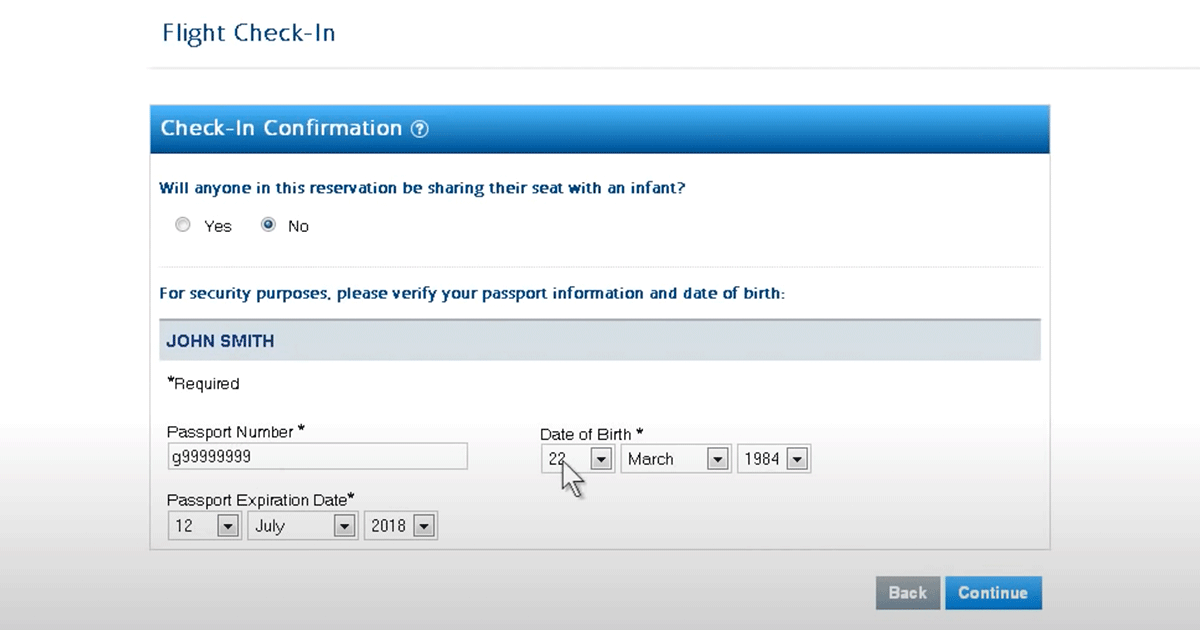 Check-in example
Check-in exampleWhy do airlines never offer travelers their favorite seats onboard? Instead, travelers must manually enter their personal details and select the same seat every time they travel. I have been doing so for 15 years now and I have no idea when it might change. Airlines today are more like e-commerce companies, much more than ones focused on transportation. The internet technologies supporting them are more important for airline companies than the airplanes themselves. We have seen how companies disappeared after failing to adapt to the modern requirements of the users, not the passengers, even while having super-modern aircraft in their fleets.
The aviation industry is in need of significant changes. Shopify has managed to completely transform the process of creating and managing online stores. Why not try to do this with airlines and create a convenient, modern service tailored for them? A vertical SaaS platform specifically designed for the needs of airlines.
Having the necessary knowledge of the industry, I decided to go on and validate my hypothesis. How could I check the viability of the idea? It would have been logical to ask the airlines themselves. So, I started writing to contacts on LinkedIn working in airlines to share my idea and get their feedback. My first message was akin to something like this:
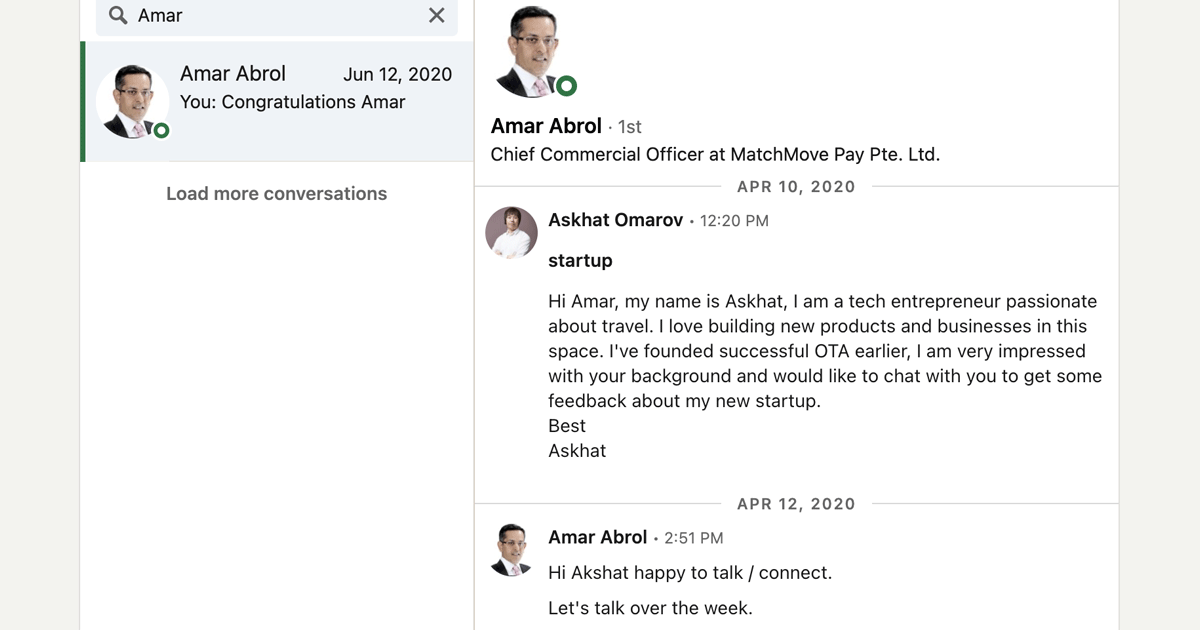 LinkedIn conversation
LinkedIn conversationAlthough the message lacks any details, surprisingly, I received positive responses about 30% of the time from contacts willing to discuss the matter. Among them were many C-level managers who were ready to discuss my idea. For example, Amar Abrol, CEO of AirAsia India, answered me. He has since left the company to found his own startup.
Surprisingly, top managers were ready to spend hours discussing aviation software. They talked about the problems of current systems, why they do not work, what needs to be fixed, and so on. They complained that they did not have any leverage as customers that would allow them to change anything. I have touched upon a very important topic for them. I felt that they are very displeased with the current state of affairs. If I came to them with a proposal for onboard catering, I am sure that only a few would have answered me. The reaction was different here. Some were impressed with the idea and had started asking questions, sharing their thoughts. Some were skeptical, as they did not believe that it was possible to defeat the giants. In any case, there was interest in the idea, which means that there is demand for it on the market.
Despite the fact that I was already sure that the idea was worth dedicating the next 10 years of my life to, I felt the lack of a magical kick. At that moment, I had an active, rather large business, and I really like working in a focused way on one thing at a time. I also had a long-term dream of getting into the Y Combinator. And so, I thought that this was the perfect opportunity to get some additional validation. It was incredibly interesting for me to get their opinion. I applied and was able to get distracted for a while. Ten days later, I got an answer and was invited for an interview. Another 2 weeks later, I was accepted into the batch.
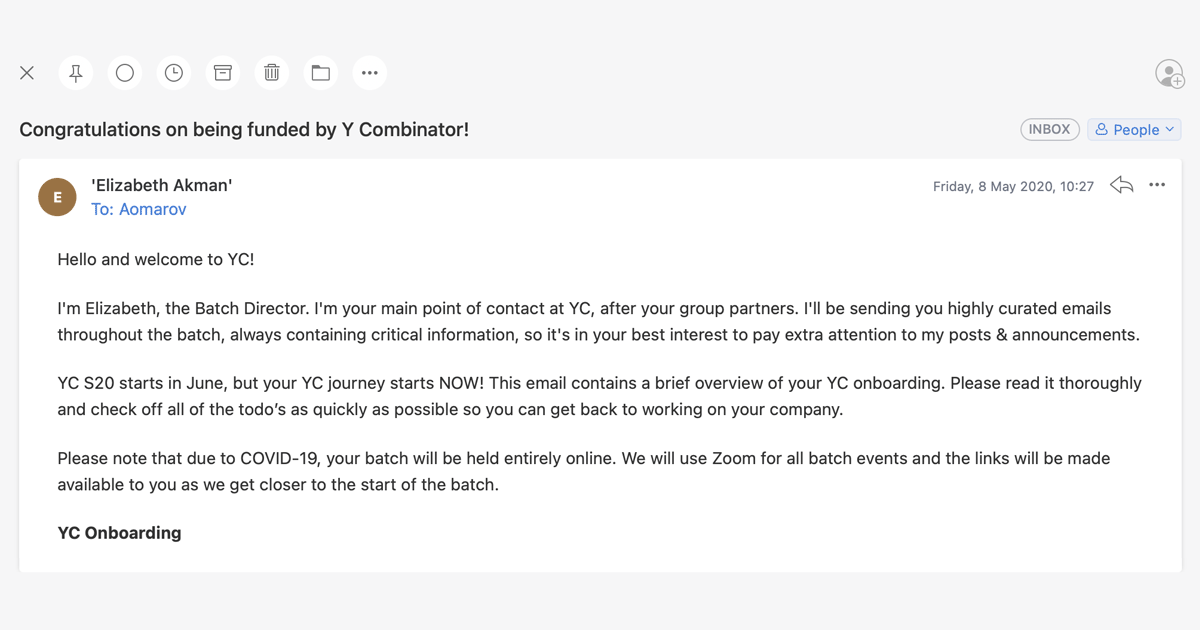 YC letter
YC letterWhile preparing for the interview, I found a buyer for my existing business, and by the start of the batch, I could fully focus on Farel. I think this is an almost ideal format for how startups should be launched, from idea to validation and then to Y Combinator. In my case, it is also a successful exit. At first, I could not believe that this was real and it was happening to me.
After receiving the first investment from YC, I did not start working on the software straight off. I had to figure out where to start. When you are a startup, it is better to be a needle than a mallet. After hearing this phrase at one of the YC events, it dawned on me that the platform should not be made for everyone together taken, but that focus should be directed at small, regional airlines. They do not have the complex operations that major airlines do, so it is easier for us to design our solution. These airlines have a number of features specific to them. For example, there is no dedicated personnel responsible for strategy formation and the planning of company development for 5-10 years, since they are faster in making decisions. Often, the business of small airlines is supported by 3-4 top managers. They do not have that many resources. Such airlines live in their own isolated world, they do not fear much competition from large airlines because of the structure of their fleets, as it simply unprofitable for them to compete on regional routes.
It seemed that working with small airlines would be difficult. However, in reality, this segment is deprived of attention. Amadeus and Sabre target major airlines. We managed to establish working relations with seven airlines and they became our partners. At first, we talked a lot with airlines from the Eastern Europe, since this market is historically closer to us. But now we are communicating with companies from the US, Latin America, Asia, and Africa. We want to have 1-2 partners in each local market. Basically, all of the companies have common problems, but there are some specifics. The main challenge is finding a person within the company who is interested in innovation. That person will become your guide in your account and will organize your workflows with the relevant departments.
Our partner companies have also gotten involved rather actively in our work process. The cooperation is structured like this – we take on a certain function, for example, creating a flight schedule and the people in the company tell us how their processes are built, and about their pains. We start working on this feature and build as we see it, and they give their comments and corrections. We deploy new functions about once a month and ask for feedback.
Why are the airlines so involved in helping us? First of all, it is because they are interested in change. Secondly, we work closely with the employees who work with the software in the airlines. They are interested in seeing something new and participating in the creation process. Another important factor is progress. When they see progress every month that exceeds their expectations, their interest grows.
Our service can cover about 70% of the needs of small airlines. During the summer, we plan to move on to active implementation. But we already have clear evidence that airlines need a simple and convenient cloud service with site templates, fast schedule changes, the ability to create mobile applications in two clicks and so on. But the most important thing is that with such a service, the time-to-market indicator will be a week, and not several months, as it is now.
We were lucky, since the initial idea hit the market well and found early adopters and contribution partners. But many entrepreneurs are also confident in their ideas and rush headlong into development, spending money, bringing them to the market, but in the end, it turns out that no one needs their products. Take your time right from the start to validate your idea with people in the industry that you are targeting. You may be thinking in the right direction but communicating with industry representatives will help you better understand the market. Moreover, you will receive additional motivation and find partners who will help you develop your project. Try applying to Y Combinator and other top accelerators, as this is the best way to start your transformation from idea to business. Of course, during the development process and greater immersion into the problem, your idea will undergo changes, you will prove its viability by traction, test a bunch of hypotheses, but this is a separate topic, perhaps one for the next post.
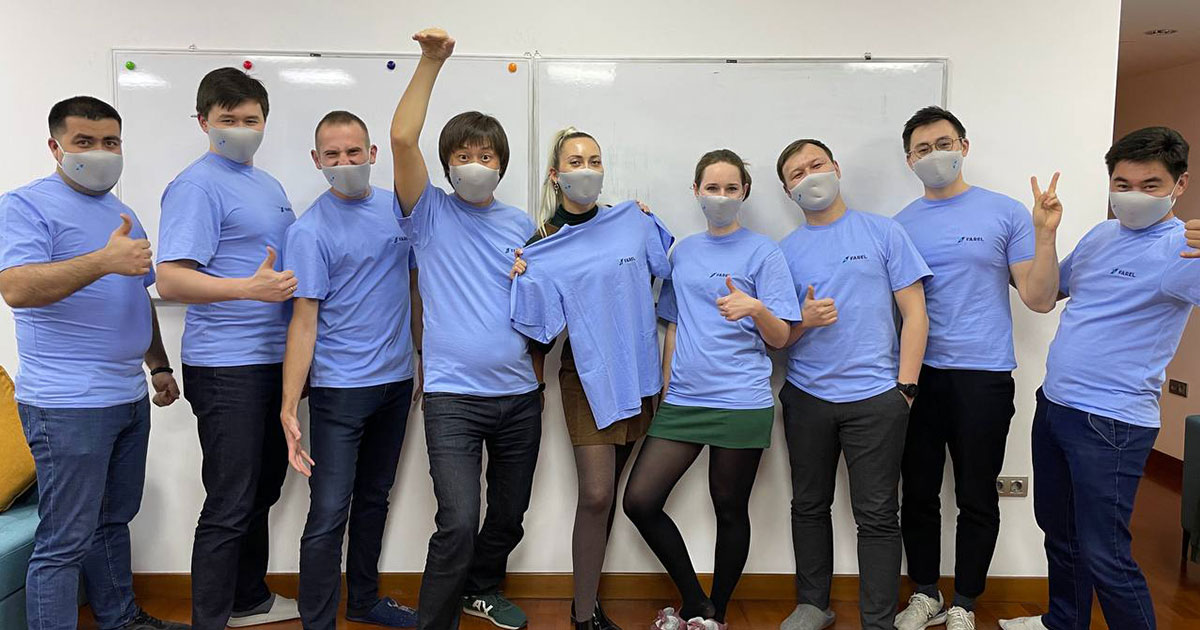 Happy moments of work routine
Happy moments of work routine

